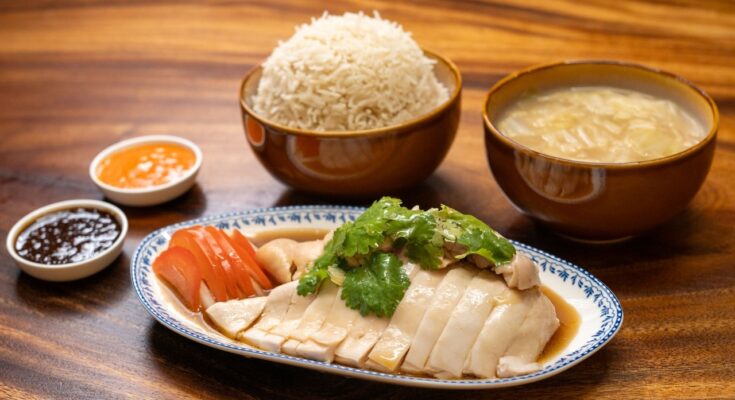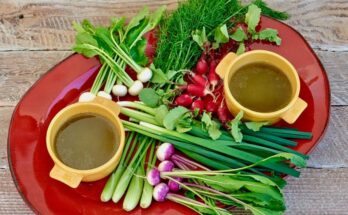Hainan Chicken Recipe: When it comes to comfort food that is both simple and incredibly flavorful, Hainanese Chicken Rice is at the top of the list. Originating from the island of Hainan in China and made popular across Southeast Asia, especially in Singapore and Malaysia, this dish has earned its reputation as a national treasure. It’s not just a meal—it’s an experience. Imagine tender, juicy poached chicken paired with aromatic rice cooked in rich chicken broth, served with dipping sauces that wake up your taste buds. That’s Hainanese chicken rice in its purest form.
What Makes This Dish So Special
Unlike heavily spiced or fried dishes, the magic of Hainanese chicken rice lies in its simplicity. The chicken is gently poached to keep the meat silky and moist. The rice is not just plain rice—it’s cooked with chicken fat, garlic, and ginger, making it incredibly fragrant. Finally, the sauces—chili, ginger-garlic, and soy—add layers of flavor that elevate the dish from ordinary to unforgettable.
Origins of Hainanese Chicken Rice
This dish has roots in Hainan, a southern Chinese island, but its fame spread when immigrants brought the recipe to Singapore. Over the years, it has become a signature Singaporean dish, with variations found in Thailand, Malaysia, and beyond. While the basic concept remains the same, each region adds its unique touch. In Singapore, it’s a hawker center classic; in Malaysia, it’s often served with roasted chicken as an alternative.
Ingredients You’ll Need
Cooking this dish at home may seem intimidating, but the ingredient list is straightforward. Let’s break it down into three main categories: chicken, rice, and sauces.
Main Ingredients for Poached Chicken
- 1 whole chicken (about 3–4 lbs)
- 2 tablespoons salt (for scrubbing and seasoning)
- 1 large knob of ginger, sliced
- 5 cloves garlic, smashed
- 5 stalks green onions (scallions)
- Enough water to submerge the chicken
Ingredients for Fragrant Rice
- 2 cups jasmine rice (rinsed and drained)
- 3 tablespoons chicken fat or vegetable oil
- 3 cloves garlic, minced
- 1-inch ginger piece, minced
- 3 cups chicken broth (reserved from poaching)
- 1 teaspoon salt
Essential Sauces and Condiments
Chili Sauce
- 4–5 red chilies
- 2 cloves garlic
- 1-inch ginger
- 1 tablespoon lime juice
- 1 teaspoon sugar
- Salt to taste
Ginger-Garlic Sauce
- 2-inch ginger, grated
- 3 cloves garlic
- 2 tablespoons vegetable oil
- Pinch of salt
Soy Sauce Mixture
- 3 tablespoons light soy sauce
- 2 tablespoons chicken broth
- 1 teaspoon sesame oil
Kitchen Tools You’ll Need
While the recipe doesn’t call for fancy gadgets, having the right tools can make your cooking process smoother and more efficient.
Cooking Utensils and Equipment
- A large stockpot (big enough for a whole chicken)
- A strainer or slotted spoon
- A rice cooker (optional, but very helpful)
- A blender or food processor (for sauces)
- Sharp kitchen knife
- Chopping board
Tips for Preparation Efficiency
- Prepare your sauces while the chicken is poaching to save time.
- Always rinse your rice well before cooking to remove excess starch.
- Have an ice bath ready before you start cooking the chicken—this step is crucial for texture.
Step-by-Step Guide to Making Hainanese Chicken Rice
Now, let’s dive into the actual cooking process. The beauty of this dish is that each component—chicken, rice, and sauces—comes together harmoniously.
Step 1 – Preparing the Chicken
Start with a whole chicken, preferably fresh and around 3–4 pounds. Clean it thoroughly, then rub it with a little salt to exfoliate the skin (this gives it that signature smooth texture). Rinse it well and place it in a large pot of boiling water. Lower the heat to a gentle simmer and poach the chicken for about 35–45 minutes, depending on its size. Once cooked, immediately transfer it to an ice bath to stop the cooking process and keep the meat tender and juicy.
Step 2 – Making the Chicken Broth
The water used to poach the chicken becomes the flavorful base of your broth. Skim off any impurities, then add ginger, garlic, and scallions to enrich the flavor. This broth will serve two purposes: as a soup to accompany the meal and as the liquid to cook the rice.
Step 3 – Cooking the Rice in Chicken Fat and Broth
Render a few tablespoons of chicken fat in a pan. Sauté minced garlic and ginger in the fat until fragrant, then stir in the uncooked rice to coat each grain. Transfer the rice to a rice cooker or pot, then cook it using the reserved chicken broth instead of plain water. This step infuses the rice with incredible aroma and flavor, making it the heart of the dish.
Step 4 – Making the Sauces
Hainanese chicken rice is incomplete without its trio of sauces. Prepare a chili sauce with red chilies, garlic, ginger, lime juice, and a touch of sugar. Make a ginger-scallion oil by blending fresh ginger, scallions, and hot oil. Finally, serve with dark soy sauce for a savory punch. Each sauce adds its own dimension to the dish.
Step 5 – Serving the Dish
Carve the poached chicken into bite-sized slices and arrange them neatly on a plate. Serve alongside the fragrant rice, a small bowl of the chicken broth, and the three dipping sauces. Garnish with fresh cucumber slices and cilantro for a refreshing touch. This comforting dish is best enjoyed warm and shared with family or friends.
Expert Tips for Authentic Flavor
If you’ve ever had Hainanese chicken rice from a hawker stall in Singapore, you know it’s hard to replicate at home. But with a few tricks, you can get surprisingly close.
How to Keep Chicken Tender and Juicy
The key is gentle poaching. Keep the water at a bare simmer, never a rolling boil. Once cooked, the ice bath is non-negotiable—it stops overcooking and keeps the skin firm. Always let the chicken rest before chopping to lock in juices.
Secrets to Perfect Fragrant Rice
Rinsing jasmine rice multiple times removes excess starch, preventing clumps. Sautéing the rice with garlic and ginger before cooking enhances the aroma. And of course, always use broth instead of water.
Adjusting Sauces to Your Taste
Don’t be afraid to tweak the sauces. Add extra lime for more tang in the chili sauce, or more sesame oil for a nuttier soy sauce. The sauces should balance your personal taste preferences while complementing the chicken.
Variations of Hainanese Chicken Rice
While the classic poached version is the most authentic, Hainanese chicken rice has evolved across regions and households. Depending on your preference, you can experiment with different variations while still keeping the essence of the dish intact.
Roasted Hainan Chicken
If you love a slightly smoky, caramelized flavor, roasted chicken is an excellent alternative. Instead of poaching, marinate the chicken with soy sauce, sesame oil, and a touch of honey, then roast it until golden brown. The result is crisp skin with juicy meat inside. Although it strays from the traditional silky texture, roasted chicken pairs beautifully with the same rice and sauces.
Steamed Chicken Alternative
For a lighter take, you can steam the chicken instead of poaching it. Steaming preserves the natural flavors of the chicken while keeping it moist. The cooking time is similar to poaching, but the result is cleaner, with a delicate aroma. It’s a great choice if you prefer a healthier version with less fat.
Vegetarian or Vegan Versions
Don’t eat meat? No problem. Replace chicken with firm tofu or king oyster mushrooms. Poach or steam them with ginger and garlic to mimic the flavors. For the rice, use vegetable broth instead of chicken broth, and make similar sauces minus the chicken fat. You’ll still get that fragrant, comforting taste but in a fully plant-based way.
Nutritional Value of Hainanese Chicken Rice
This dish might feel indulgent, but it’s surprisingly well-balanced when eaten in moderation.
Health Benefits of Ingredients
- Chicken: A lean source of protein, essential for muscle growth and repair.
- Ginger and Garlic: Both are natural immune boosters with anti-inflammatory properties.
- Rice: Provides carbohydrates for energy, though portion control is key.
- Chili: High in vitamin C and boosts metabolism.
Calories and Macronutrients
On average, a serving of Hainanese chicken rice (with chicken, rice, and sauces) contains:
- Calories: 600–700 kcal
- Protein: 25–30g
- Carbohydrates: 60–70g
- Fat: 20–25g
Of course, this varies depending on portion size and preparation. If you’re health-conscious, you can reduce chicken fat in the rice or serve smaller rice portions while enjoying more chicken and vegetables.
Common Mistakes to Avoid
Even though the recipe seems simple, a few missteps can ruin the dish. Here’s what to watch out for:
Overcooking the Chicken
This is the number one mistake. Boiling the chicken at high heat will make the meat tough and dry. Always keep the liquid at a gentle simmer and test for doneness by piercing the thickest part of the thigh.
Using the Wrong Rice
Jasmine rice is non-negotiable here. Other rice varieties won’t give you the same fluffy, aromatic result. Long-grain jasmine rice has just the right balance of softness and fragrance.
Skipping the Ice Bath Step
It might sound unnecessary, but skipping the ice bath will result in soggy skin and overcooked chicken. The cold water shock tightens the skin, giving it that smooth, silky finish that Hainanese chicken is famous for.
Pairing Suggestions
While Hainanese chicken rice is a complete meal on its own, a few side additions can make it even more satisfying.
Best Side Dishes
- Blanched Asian greens like bok choy or kai lan with oyster sauce.
- Pickled vegetables for a tangy contrast.
- Steamed eggs for extra protein.
Drinks That Complement the Dish
- A warm cup of Chinese tea helps cleanse the palate.
- Soy milk offers a mild, creamy pairing.
- If you’re adventurous, try it with a light lager beer—refreshing and crisp.
Storage and Reheating Tips
Hainanese chicken rice tastes best fresh, but it can be stored for later if handled properly.
How to Store Chicken and Rice Separately
- Chicken: Store in an airtight container with some broth to keep it moist. Refrigerate for up to 3 days.
- Rice: Let it cool before storing in a container. Refrigerate for up to 2 days.
- Sauces: Keep in small jars and refrigerate. They usually last 3–5 days.
Best Way to Reheat Without Losing Flavor
- Reheat chicken gently in hot broth, not the microwave, to prevent dryness.
- Warm rice by steaming or microwaving with a damp paper towel on top to keep it fluffy.
- Always serve with freshly heated broth and sauces to bring the dish back to life.
Serving Ideas for Special Occasions
Hainanese chicken rice isn’t just for weeknight dinners—it’s perfect for gatherings and celebrations too.
Family Dinners
Serve the chicken whole and carve it at the table for a homely, shared experience. It’s a comforting meal that appeals to both kids and adults.
Party or Gathering Presentation
Plate the chicken on a large platter with garnishes, serve the rice in a clay pot for extra flair, and place sauces in small dipping bowls. Add some side dishes like stir-fried greens or wontons to make it a feast. Guests will love the interactive aspect of choosing their sauces and customizing each bite.
FAQs about Hainan Chicken Recipe
1. Can I use brown rice instead of jasmine rice?
Yes, but the texture and fragrance will be different. Brown rice adds nuttiness and more fiber, though it won’t have the same soft, fluffy finish.
2. How long does it take to make Hainanese chicken rice?
On average, about 1.5 to 2 hours including preparation, poaching, cooking rice, and making sauces.
3. What can I substitute for chicken fat?
Vegetable oil works, but it won’t be as flavorful. For a similar richness, you can use a small amount of butter or duck fat.
4. Is Hainanese chicken rice gluten-free?
Yes, if you use gluten-free soy sauce in the dipping sauce. The rest of the dish is naturally gluten-free.
5. Can I prepare the sauces in advance?
Absolutely. You can make the sauces a day or two before and store them in the fridge. Just bring them to room temperature before serving.
Conclusion
Hainanese chicken rice is proof that simplicity can create extraordinary results. With just a few humble ingredients—chicken, rice, ginger, garlic—you get a dish that’s comforting, fragrant, and deeply satisfying. Whether you stick to the traditional poached version or explore roasted or vegetarian variations, the heart of the dish lies in the balance of tender chicken, aromatic rice, and vibrant sauces.
Making it at home may take some practice, but once you master the steps, you’ll have a dish that rivals any hawker stall. It’s not just food—it’s a piece of culinary culture shared across generations and borders.



